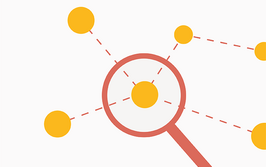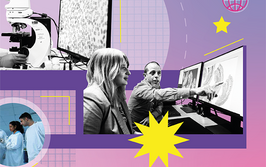The Pathology Promoter
Teaching patients about their diagnoses, either one-on-one or in group settings, is good for all involved – and for the future of our profession
As we make increasing amounts of information in medical charts directly available to patients, we pathologists must be prepared to offer explanations. Often, the clinicians who request pathology services don’t have the time to explain the results – and that’s where patient-centered pathology comes in. To me, the term denotes the involvement of the pathologist in explaining their findings – and the implications for medical care – to patients. And that can happen one-on-one or in a group setting.
I was recently involved in a patient-centered symposium called “Affairs of the Heart: Living with Hypertrophic and Dilated Cardiomyopathy” (1). The aim of the one-day, multidisciplinary educational event was to teach heart failure patients a little about the anatomic changes and the genetics of cardiomyopathy. I was lucky enough to have been invited by the cardiologists at my institution, and I – the cardiothoracic pathology fellow – jumped at the chance. I brought along a few specimens from our collections, which allowed me to show the patients exactly what it means, from a tissue standpoint, to have a hypertrophic or dilated heart. What’s enlarged? What’s abnormal? What does an artificial valve look like? It was amazing to see how meaningful such information was to those people directly affected by heart disease. It was a first for me – I’ve never done anything like that with patients – and a first for those there to learn; many of them had no idea what a dilated or hypertrophic heart actually looked like, despite living with one day in and day out. I was touched to witness their reactions as they suddenly understood what their disease physically meant.
How pathologists can serve patients – and vice versa
I would highly recommend that pathologists participate in this kind of focused, organized event, if you get the opportunity. You’ll be amazed at the difference a little education makes to your patients. And, of course, such forums aren’t limited to affairs of the heart. Take colon cancer as an example; do patients understand what their disease looks like or what the terminology signifies from a pathologist’s point of view? What’s microinvasive disease? What does it mean to have a T1 or a T3 tumor? Most patients have no idea – but with a disease as common as colon cancer, a patient symposium would be an efficient platform to provide welcome education, and an easy way to make patients feel more comfortable and at ease with their care.
Events aren’t the only way to communicate with patients, though. Now that patients frequently see their own pathology reports (and the names of the pathologists who wrote them), they sometimes reach out to the pathologists themselves to ask questions. The trend may have been prompted somewhat by advances in molecular pathology, where we often issue complex reports – results and interpretations of targeted sequencing panels for different tumors, inborn errors of metabolism, mitochondrial disorders, and so on – that even the clinicians can’t always fully understand or act upon. Sometimes, there simply isn’t any action to be taken. Nevertheless, the patients are still curious – after all, they’re trying to observe and comprehend their own genome! When they come to us and ask, “What does this mean?” I think it’s our responsibility to answer – and to make sure we do so in a way our patients can understand.
I find that talking with patients and teaching them about their disease processes brings me closer to the art of practicing medicine. Some of that depends on where you practice; in the current for-profit healthcare system in the US, for instance, I find that production is sometimes emphasized over quality of delivery. Pathologists and radiologists – those of us who don’t often see patients directly – can easily lose sight of why we’re practicing medicine in the first place. It’s a little like we become abstracted from our mission. If you interact with patients – ideally in person, but at least over the phone or by email – I think it helps restore some balance to what should be an altruistic profession. In my opinion, that’s the greatest benefit we pathologists can get from patient-centered pathology.
From pathology to primary care
Clinicians generate the biopsies; we interpret them. At my institution, we have discussed the possibility of a more targeted approach to biopsying various disease processes to yield better results. Often, biopsies aren’t taken exactly where we need them – they might come from next to the lesion, or from the middle instead of the edge – so we are unable to get as much information as we’d like. We are working with clinical staff to improve that. The other thing we need is better utilization management; we should not do biopsies when they’re not needed. Sometimes, things that don’t need to be sent for pathology get sent anyway. Then, of course, we have to take the biopsy through to the reporting stage, which means the patient has not only undergone an unnecessary procedure, but that they are also facing unnecessary costs. My goal is to establish a continuous, two-way conversation between primary care and pathology, so that we can reduce unnecessary testing and improve necessary testing.
If the idea of patient-centered pathology intrigues you, I suggest that you take up the practice early. If you don’t, then it may be forced upon you later in your career, once you’ve grown used to your own way of doing things. Seek it out as early as possible – during training, if possible – and explore what different avenues are available. That said, if you’re already 40 years into practice, it doesn’t mean you can’t or shouldn’t go and ask your clinical group about opportunities for patient interaction. It’s never too late to start!
The one factor that isn’t up to us as pathologists is time. In my experience, physicians of every specialty are pressed for time, and the topic comes up frequently when discussing the idea of patient interactions. Pathologists tell me that they’re concerned about the amount of time it takes, and – in the United States, at least – it’s unfortunately not billable time. I do think, though, that it is time well spent. I think people should try to take a step back and consider what it might mean to the patient to be educated about a new diagnosis by an expert they can trust. Better knowledge won’t only reassure them; it might also encourage them to modify their behaviors, adhere to medication regimens, and overall improve the health of the group. With a simple introduction to pathology, we can have a knock-on effect on population health.
Shifting the stereotype
There is a common misperception that pathologists don’t have any patient contact. I’ve heard many medical students repeating this false impression: “Pathology is a pretty good gig, except that you don’t get to interact with patients anymore.” Well, I’m a pathologist, and I find patient contact incredibly rewarding. And I firmly believe that there would be many more people interested in practicing pathology, if people realized that it can be just as much of a person-to-person discipline as any other specialty. Shining the spotlight on patient-centered pathology is great for both healthcare in general and the future of our field.
- Duke Pathology, “de Ridder presents patient-centered pathology sessions” (2017). Available at: bit.ly/2jVoMVG. Accessed November 24, 2017.
Gustaaf de Ridder is a Clinical Associate in the Department of Pathology at Duke University, Durham, USA.




















